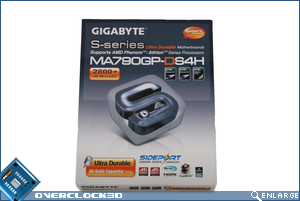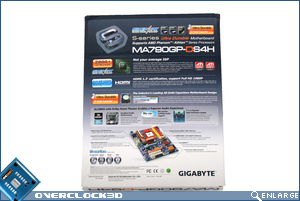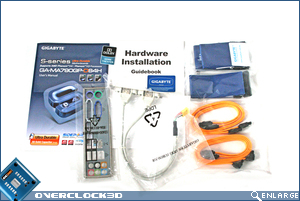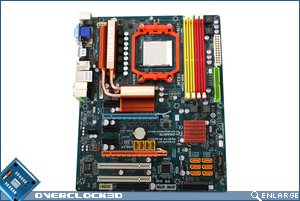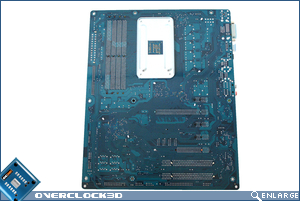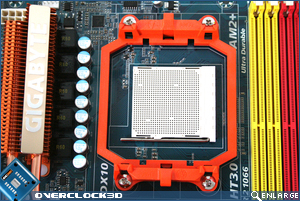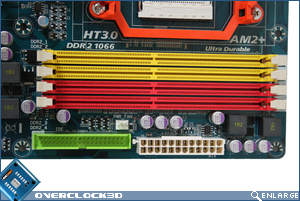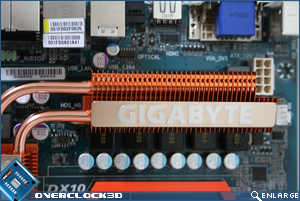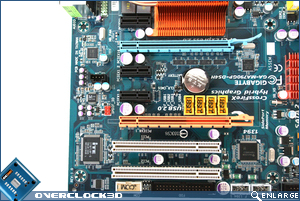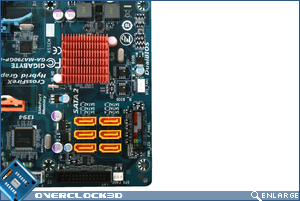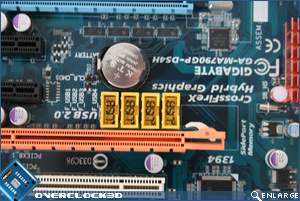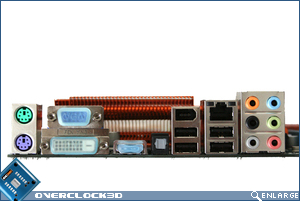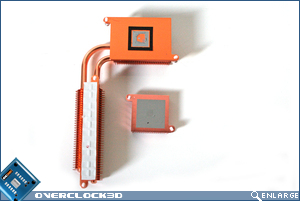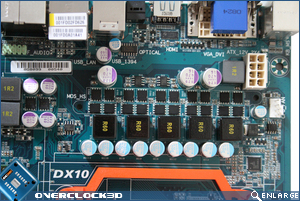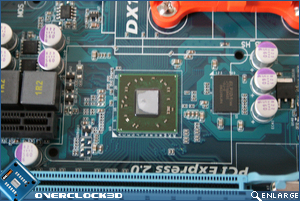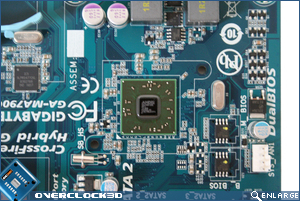AMD 790GX Head to Head
Gigabyte MA790GP-DS4H
Â
Packaging & Appearance
Â
The Gigabyte MA790GP-DS4H takes on a different approach to the MSI in that there is no weird alien race looking to hunt you down, gone are the spacecraft and motherships of yesteryear replaced instead by a basic, minimalist yet professional and mature design. Beauty, as they say, is in the eye of the beholder but in my humble opinion the Gigabyte offering is a much more sublime and attractive design which perhaps is intended to appeal to the more mature end of the market. Of course I could be speaking utter tosh here but, at thirty something I feel like a spotty teenager buying items with aliens and gargoyles on the front of PC products, so this is, for me at least, a much more attractive package.
Â
Â
Like the MSI, the Gigabyte board offers similar features in being ATI Crossfire compatible and having Sideport Memory. The Gigabyte board also offers something which the MSI does not – DualBIOS which is often taken for granted on Gigabyte boards as it has been around for sometime now but it is still revered as a valuable feature, especially come the dreaded BIOS update time. The rear of the package goes on to advertise the IGP Radeon HD3300 graphics core, 128mb of Sideport Memory, full HD 1080p Blu-Ray playback capability and an all-solid motherboard capacitor design.
Â
Â
In comparison to the MSI, the accessories are sparse. Immediately apparent is the missing Crossfire bracket. Lacking a Crossfire bracket is not the best idea considering this is a Crossfire capable motherboard and especially as MSI are generous enough to include two! Four Quick latch SATA cables are included however along with an IDE and floppy ribbon cable. For the price of the motherboards on test today IÂ would prefer to have seen the inclusion of rounded IDE/Floppy cables but both parties are guilty of this crime, not just the Gigabyte. The backplate is clearly labelled so there should be no confusion as to which port is which and along with the USB PCI bracket, this completes the included accessories for the Gigabyte board.
Â
Â
Like the MSI, Gigabyte are keen to continue the ‘explosion in a Crayola factory’ theme, utilising a range of colours which don’t particularly follow any order. If the board was aimed at the enthusiast aged from 2+ then that would be OK but I don’t believe for one second Gigabyte are in competition with Mothercare. While this may not be an issue with users who don’t have a window in their case, those that do may consider the colour scheme to be enough not to buy a motherboard, such is the high standard of competition these days.
Â
Luckily for Gigabyte though, it does redeem itself with the actual design of the motherboard. Everything is in pretty much the right place with the majority of the ports situated on the perimeter of the motherboard. If there was one fault I could aim at the board (colour aside), it would be the SATA placement. IÂ would prefer to have had them at the very edge of the board and possibly at a 90 degree angle. The inner most SATA ports may become blocked if a large GPUÂ is used in the 2nd PCI slot.
Â
Â
The CPUÂ socket area is once again clear of obstruction with the Mosfets neatly aligned to the left of the socket. In contrast to the MSI board, Gigabyte have opted to connect the Mosfet cooler to the Northbridge via the dual heatpipes. Also worthy of note is that the Gigabyte has the option to use an 8 pin ATX12v PSU socket as opposed to the 4 pin on the MSI. The ram slots aqain are situated close to the CPU socket as with the MSI.
Â
Â
The MA790-DS4H appears ot have very good cooling with copper heatpipes connecting the Mosfet cooler to the Northbridge cooler serving to share the heatload. The Southbridge cooler is a standalone affair which should be fine as the southbridge does not get too hot anyway.
Â
Â
The PCI area of the board is crammed full of goodies with 3 PCIe x1 slots, 2x PCIe x16 slots, and a further 2 standard PCI slots further down the board. This should ensure the user has plenty of options when inserting expansion cards. Interestingly, the Gigabyte board also has an additional 4 USB headers but these are above the 2nd PCIe x16 slot, a strange place to put them but as the bottom of the board is taken up with other ports it is not such a bad place. I would however like to have seen them spaced out a little more as cables in that area will be very cramped if all four headers are utilised.
Â
Â
The I/O area is similar in layout to the MSI but instead of adding further USB ports, Gigabyte have opted to include the dated PS/2 Mouse port. VGA/DVI and HDMI ports are clearly visible and it is nice to see Gigabyte have taken the trouble to provide covers for said ports to protect the area from dust intrusion. A single Firewire and LAN port are accompanied by 4 USB 2.0 ports and are straddled by an Optical output and the main 3.5mm audio jacks. Personally IÂ would have preferred to see more USB connectivity here as four is miserly on a high end board. Granted the Gigabyte provides additional headers and a PCI bracket to expand the USB connections but if you have alot of expansion cards already, this won’t leave much room to use the USB bracket..
Â
Â
The Gigabytes coolers, while appearing to be copper are not. They are either a composite metal or copper coated aluminium (most likely the latter). While this is at a slight detriment to cooling, the costs are kept down by using such materials. The whole heatsink assembly was easy to remove thanks to the plastic push-pin method of attachment but IÂ would liked to have seen screws used instead of the push-pin method as a much more secure and even mount can be had with the screw method of attachment. Having said that, the contact between the heatsink and the chipset appeared to be fine albeit only the Northbridge had paste used with the Southbridge and Mosfet areas using thermal tape.
Â
Â
All in all a very well laid out board and while I would have liked to have seen more USB ports on the I/O area, Gigabyte have at least given the user the option to expand the USB ports should the require them.
Â
Let’s take a look at the DS4H’s BIOS…



